
Kadisha Valley, also romanized as the Qadisha Valley and also known as the Kadisha Gorge or Wadi Kadisha, is a gorge that lies within the Bsharri and Zgharta Districts of the North Governorate of Lebanon. The valley was carved by the Kadisha River, also known as the Nahr Abu Ali when it reaches Tripoli. Kadisha means "Holy" in Aramaic, and the valley is sometimes called the Holy Valley. It has sheltered Christian monastic communities for many centuries. The valley is located at the foot of Mount al-Makmal in northern Lebanon.

Ehden is a mountainous city in the heart of the northern mountains of Lebanon and on the southwestern slopes of Mount Makmal in the Mount Lebanon Range. Its residents are the people of Zgharta, as it is within the Zgharta District.
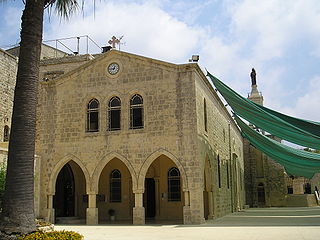
The Church of Saidet et Tallé, sometimes spelled Saydet El Talle and translated as Our Lady of the Hill, is a Maronite church in Deir el Qamar in Lebanon. It is one of the most important historical and religious sites in Deir el Qamar and dates to the 16th century.
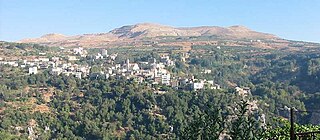
Kfarsghab is a village located in the Zgharta District in the North Governorate of Lebanon. It is situated in the Valley of Qadisha, which is considered a holy and spiritual place in Eastern Christianity The main religion of its residents is Maronite Catholicism.
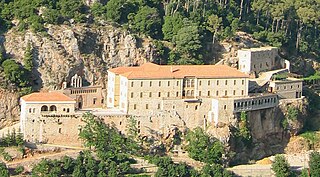
Qozhaya, also transliterated Qazahya is located in the Zgharta District in the North Governorate of Lebanon. It belongs to the Lebanese Maronite Order known as Baladites.

Saint Awtel was a monk of the 1st centuries of Christianity venerated in the Middle East. He is celebrated on 3 November, and on 9 October. A church is dedicated to him in the village of Kfarsghab in North-Lebanon where his feast day is celebrated on 3 June and 27 August.

In Ehden, Lebanon, Mar Sarkis is a monastery of the Antonins. It is located in the Zgharta District of the North Governorate, in the Qozhaya valley. It overlooks Ehden, Kfarsghab, Bane and Hadath El Jebbeh. Given its exceptional location commanding the valley at 1500 meters altitude, the monastery is called the Watchful Eye of Qadisha.
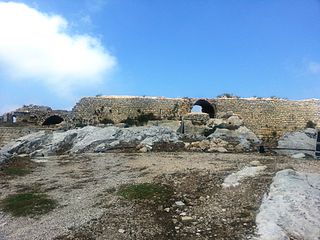
Smar Jbeil is a village located in the Batroun District in the North Governorate of Lebanon. It is located on a hill facing the Mediterranean Sea at 500 m elevation. It is one of the oldest villages in Lebanon.
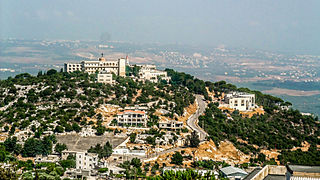
Karmsaddeh is a village located in the Zgharta District in the North Governorate of Lebanon. Its population is predominantly Maronite Catholic. Within the village center is Saint John's Church. Saint John is the patron Saint of Karmsaddeh.
Aitou is a village located in the Zgharta District in the North Governorate of Lebanon. Its population is Maronite Catholic.
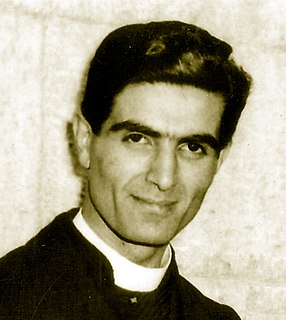
Youakim Moubarac was a Lebanese French scholar. He was an Islamologist, an Arabist and a disciple of the Orientalist Louis Massignon and of philosopher Louis Gardet. A Maronite priest, Moubarac dedicated his life and major works to interfaith dialogue between Christianity and Islam, to Arab and Lebanese causes, to the unity of the Church and to the Maronite Church Antiochian heritage.
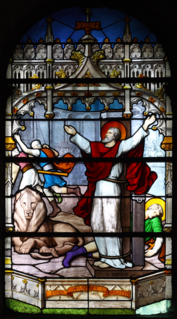
Saint Mammes of Caesarea was a child-martyr of the 3rd century, who was martyred at Caesarea. His parents, Theodotus and Rufina, were also martyred.
The Mariamite Maronite Order, also called the Aleppians or Halabites), is a monastic order in the Levantine Catholic Maronite Church, which from the beginning has been specifically a monastic Church. The order was founded in 1694 in the Monastery of Mart Moura, Ehden, Lebanon, by three Maronite young men from Aleppo, Syria, under the patronage of Patriarch Estephan Douaihy (1670–1704).

The Baladites, formally known as the Lebanese Maronite Order, is a monastic order among the Levant-based, Catholic Maronite Church, which from the beginning has been specifically a monastic Church. The order was founded in 1694 in the Monastery of Mart Moura, Ehden, Lebanon, by three Maronite young men from Aleppo, Syria, under the patronage of Patriarch Estephan El Douaihy (1670–1704).

The tourism industry in Lebanon has been important to the local economy historically and to this day comprises a major source of revenue for the country. Before the Lebanese Civil War, Beirut was widely regarded as "The Paris of the Middle East" or also "The Pearl of the Middle East" often cited as a financial and business hub where visitors could experience Levantine Mediterranean culture, cuisine, history, archaeology, and architecture of Lebanon.

Estephan El Douaihy was the 57th Patriarch of the Maronite Church, serving from 1670 until his death. He was born in Ehden, Lebanon. He is considered one of the major Lebanese historians of the 17th century and was known as “The Father of Maronite History”, “Pillar of the Maronite Church”, “The Second Chrysostom”, “Splendor of the Maronite Nation”, “The Glory of Lebanon and the Maronites”. He was declared Servant of God by the Congregation for the Causes of Saints under Protocol number 2145. On July 3, 2008, Pope Benedict XVI authorised the Congregation for the Causes of Saints to draw up a decree on the heroic virtues of Patriarch al-Duwayhi, who will be referred to as Venerable from the moment of publication of the decree. This is an important step in the ongoing beatification process.
Ignatius Noah of Lebanon, also known as Nūḥ Pūnīqoyo or Nūḥ al-Bqūfānī, was the Patriarch of Antioch and head of the Syriac Orthodox Church from 1493/1494 until his death in 1509.

Kfarsghab in Zgharta District in the Mount Lebanon Governorate of Lebanon predates Christianity. However, like most villages in the Qadisha valley, Kfarsghab's history began with the settlement of the Maronites in Mount Lebanon during the 10th century. According to the popular tradition, the church of Saint Awtel was built on the ruins of a pagan temple. Pagan temples existed in this region as attested in the Greek inscription mentioning the date 272 AD found in the Mar Mama church in Ehden. Other temples may have existed in the region, such as the monastery of Mar Sarkis and Bakhos in Ehden, which may have been built atop ruins. Given the exceptional location of Saint Awtel's Church built on a promontory, the popular tradition about the existence of a pagan temple in Kfarsghab is plausible.
George Omaira was the 53rd Patriarch of Antioch of the Maronite Church (1634-1644).

This article lists historical events that occurred between 201–300 in modern-day Lebanon or regarding its people.















